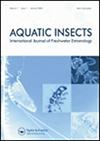On the presence of Aphelocheirus aestivalis (Fabricius, 1794) in the Iberian Peninsula: new records with morphological and molecular data (Hemiptera: Aphelocheiridae)
IF 0.6
4区 农林科学
Q4 ENTOMOLOGY
引用次数: 0
Abstract
Abstract The presence of Aphelocheirus aestivalis (Fabricius, 1794) (Hemiptera: Aphelocheiridae) in the Iberian Peninsula has been on the spot in the last decades. New records collected in northern inner plateau (Riaza River, Duero Basin) provide new insights about the presence of this species in the Iberian Peninsula. Morphological and molecular analyses confirmed the presence of A. aestivalis. Moreover, male and female genital structures and habitus illustrations are provided. As a whole, our results highlight the complex scenario of Aphelocheirus species in the Iberian Peninsula, involving three currently valid species (two of them very similar based on morphological studies) plus a cryptic undescribed lineage.伊比利亚半岛Aphelocheirus aestivalis (Fabricius, 1794)的存在:形态学和分子资料的新记录(半翅目:Aphelocheirus aestivalis)
摘要近几十年来,在伊比利亚半岛发现了一种名为Aphelocheirus aestivalis (Fabricius, 1794)的昆虫(半翅目:Aphelocheirus aestivalis)。在北部内高原(Riaza河,Duero盆地)收集的新记录为该物种在伊比利亚半岛的存在提供了新的见解。形态学和分子分析证实了该菌株的存在。此外,还提供了男性和女性生殖器结构和习性插图。总的来说,我们的研究结果突出了伊比利亚半岛Aphelocheirus物种的复杂情况,包括三个目前有效的物种(其中两个基于形态学研究非常相似)以及一个未被描述的神秘谱系。
本文章由计算机程序翻译,如有差异,请以英文原文为准。
求助全文
约1分钟内获得全文
求助全文
来源期刊

Aquatic Insects
生物-昆虫学
CiteScore
2.00
自引率
25.00%
发文量
27
审稿时长
>12 weeks
期刊介绍:
Aquatic Insects is an international journal publishing original research on the systematics, biology, and ecology of aquatic and semi-aquatic insects.
The subject of the research is aquatic and semi-aquatic insects, comprising taxa of four primary orders, the Ephemeroptera, Odonata, Plecoptera, and Trichoptera but also aquatic and semi-aquatic families of Hemiptera, Coleoptera, and Diptera, as well as specific representatives of Hymenoptera , Lepidoptera, Mecoptera, Megaloptera , and Neuroptera that occur in lotic and lentic habitats during part of their life cycle. Studies on other aquatic Hexapoda (i.e., Collembola) will be only accepted if space permits. Papers on other aquatic Arthropoda (e.g., Crustacea) will not be considered, except for those closely related to aquatic and semi-aquatic insects (e.g., water mites as insect parasites).
The topic of the research may include a wide range of biological fields. Taxonomic revisions and descriptions of individual species will be accepted especially if additional information is included on habitat preferences, species co-existing, behavior, phenology, collecting methods, etc., that are of general interest to an international readership. Descriptions based on single specimens are discouraged.
Detailed studies on morphology, physiology, behavior, and phenology of aquatic insects in all stadia of their life cycle are welcome as well as the papers with molecular and phylogenetic analyses, especially if they discuss evolutionary processes of the biological, ecological, and faunistic formation of the group.
 求助内容:
求助内容: 应助结果提醒方式:
应助结果提醒方式:


